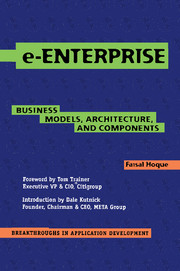Book contents
- Frontmatter
- About the Author
- Contents
- Dedication
- Foreword
- Acknowledgments
- Introduction
- PART 1 The e-Enterprise
- PART 2 Business and Application Models
- Chapter 2 e-Application Models
- Chapter 3 B-to-C e-Application Models
- Chapter 4 B-to-B e-Application Models
- PART 3 e-Enterprise Methodology and Architecture
- PART 4 Enabling Components
- Afterword: Who Will Be the Great e-Enterprises?
- References
- Index
Chapter 4 - B-to-B e-Application Models
Published online by Cambridge University Press: 20 May 2010
- Frontmatter
- About the Author
- Contents
- Dedication
- Foreword
- Acknowledgments
- Introduction
- PART 1 The e-Enterprise
- PART 2 Business and Application Models
- Chapter 2 e-Application Models
- Chapter 3 B-to-C e-Application Models
- Chapter 4 B-to-B e-Application Models
- PART 3 e-Enterprise Methodology and Architecture
- PART 4 Enabling Components
- Afterword: Who Will Be the Great e-Enterprises?
- References
- Index
Summary
No man is an Island, entire of itself; every man is a piece of the Continent, a part of the main.
—John Donne, DevotionsToday, B-to-C business models seem to command more attention and generate more interest than do B-to-B business models. This is because relationships between consumers and e-Tailers are by nature less involved and customized than those between enterprises in B-to-B relationships. B-to-B commerce is dominated by long-term, symbiotic buyer-supplier-business partner relationships where stakeholders collectively work for common interests such as lower costs and improved product and service offerings.
The astounding success on Wall Street of Amazon.com, eBay, and Priceline.com provides strong evidence that B-to-C commerce has already arrived. We've just begun, however, to explore and exploit B-to-B business models. Due to the enormous volume of spending in the B-to-B sector (companies such as General Electric and General Motors each spend over a couple billion dollars per year), the next generation of.com success stories will be dominated by B-to-B product and service providers.
Adam Brandenburger and Barry Nalebuff explore this symbiosis in their popular book Co-opetition. In the book, they introduce the concept of the “Value Net” in which customers and suppliers are both symmetrical, equal partners in creating value for the firm while competitors and “complementors” act as mirror images of one another. The Internet and its capacity for connecting organizations provides exciting new opportunities to explore and exploit the symmetries between customers and suppliers.
- Type
- Chapter
- Information
- e-EnterpriseBusiness Models, Architecture, and Components, pp. 89 - 136Publisher: Cambridge University PressPrint publication year: 2000



